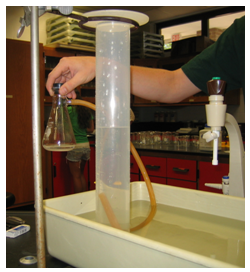Lab Investigation 5 - What is the optimum mole ratio for a reaction?
An investigation of Mole Ratios and Limiting Reactants
Guiding Question
What is the optimum mole ratio for the formation of CO2 from the reaction of sodium bicarbonate and acetic acid?Introduction
You have already learned how to balance chemical equations in terms of molecules, for example see the following equations.1
Unbalanced:
( 1 )
Mg(s) + O2(g) → MgO2
Balanced:
( 2 )
2 Mg(s) + O2(g) → 2 MgO
( 3 )
2 moles of Mg reacts with 1 mole of O2 to produce 2 moles of MgO
The Problem
When bicarbonate is mixed with acid, it breaks down into CO2 and H2O. Your task is to design and carry out an investigation to determine the optimum mole ratio for the formation of CO2 by mixing various amounts of sodium bicarbonate and acetic acid. By comparing the amount of carbon dioxide generated when varying amounts of sodium bicarbonate react with a given amount of acetic acid, you should be able to determine the optimum mole ratio of sodium bicarbonate and acetic acid and be able to identify the limiting reactant in the other reactions.Materials available for use
- 1.00 M Acetic Acid (HC2H3O2)
- Sodium Bicarbonate (NaHCO3)
- Graduated cylinders (1000 mL & 25 mL)
- Plastic tray
- Electronic balance
- Beaker (400 mL)
- Side-arm flask w/ tubing
- Ring Stands/Rings
- Eye droppers
Safety Precautions
Caution:
Handle acetic acid with care.
Handle acetic acid with care.
Caution:
Wear goggles at all times, as pressure is built up in this reaction.
Wear goggles at all times, as pressure is built up in this reaction.
Getting Started

Figure 1: Gas collection set-up
-
1Determine the optimum mole ratio of sodium bicarbonate and acetic acid.
-
2Write the balanced equation based on your data.
-
3Identify the limiting reactant in the each of the reactions.
Interactive Poster Session
Once your group has completed your work, prepare a whiteboard that you can use to share and justify your ideas. See the handout provided for details on this process.Report
Once you have completed your research, you will need to prepare an investigation report that consists of three sections. Your report should answer these questions in 2 pages or less. This report must be typed and any diagrams, figures, or tables should be embedded into the document. Generally, you need one page for the first two sections and the second page for third section.- Section 1: What concept were you investigating, and how does it relate to the guiding question? What is the optimum mole ratio for the formation of CO2 from the reaction of sodium bicarbonate and acetic acid? See the introduction for information on reaction stoichiometry, limiting reagents, and mole ratios, and then specifically link these concepts to the guiding question.
- Section 2: How did you go about your work and why? This is NOT the details of your procedure, but discussion of the processes. For example, describe the method for collecting gas and why this was necessary to answer the guiding question.
- Section 3: What is your argument? You should include the mole and mass calculations table with mL of CO2 added for each reaction. Discuss the validity and reliability of your data. Make clear your reasoning from mL of CO2 to mole ratio. Include your graph. This is where you not only present your data, but use the values you obtain as evidence in your reasoning.
- Graphing Website: http://nces.ed.gov/nceskids/createagraph/
- This third section is where you not only present your data, but also use the values you obtain as evidence in your reasoning. Statements like, "see data table for values" are not acceptable!

